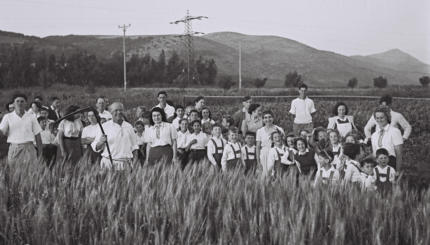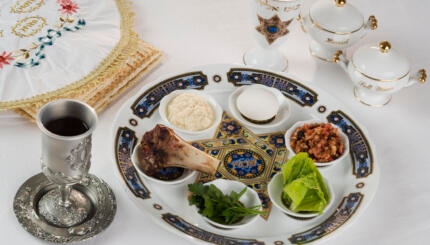Kiddush: Blessing Over Wine
The Kiddushsanctifies not the wine, but the holiday. Pesach is dedicated “to remember the Day of your Exodus from Egypt” (Ex. 13:3). [On Shabbat remember to insert the additional words in your Haggadah.]
Offer to pour the wine or grape juice into someone else’s cup. In turn each one is served by another as befits royalty. Having attained the high status of freedom, we celebrate it in style, preferably with red wine, because the rabbis considered it more elegant.
Stand to recite the Kiddush, then reclineto the left to drink the wine as befits nobles who once reclined at symposia (intellectual drinking banquets). If there are no pillows on the chairs, ask the children to bring as many as possible.
The Four Cups and the Four Verbs: The rabbis identified each cup of wine with the fourfold promise of redemption: “God spoke to Moshe [Moses]: Tell the children of Israel: I will bring you out… I will rescue you… I will redeem you… I will take you for me as a people and I will be for you as a God…” (Exodus 6:2-7).
With your help, My Jewish Learning can provide endless opportunities for learning, connection and discovery.
Photo: Flickr – Michael Ignatieff
Urhatz: Washing Hands
Jewish law requires the ritual washing of the hands before eating bread. This washing before bread is accompanied by a blessing [whereas this first washing of hands at the seder has no blessing attached to it]. But why do we wash before eating the green vegetable, and why in this case is no blessing recited?
Fruits or vegetables dipped in water can acquire ritual impurity (Leviticus 11:34). Washing before eating vegetables that have come into contact with water is a holdover from Talmudic times. In that period, many rabbis attempted to eat all their foods in a state of ritual purity–trying to experience in their daily eating the sense of sacredness associated with the Temple. To emphasize that this is only a pious custom, and not even a rabbinic requirement, no blessing is recited.
Except for the seder night, the custom has fallen into general disuse, even among the strictly observant. But on seder night we wash at the beginning of the evening to create the spirit of a sacred gathering conducted in purity and devotion.
The Many Meanings of Karpas (Spring Vegetable)
Spring Greens: Metaphorically, karpas, the spring vegetable, represents both the historic birth of Israel born out of the womb of Egypt in the Exodus and the rebirth of nature renewed each spring. According to Philo and to Rabbi Joshua, the original birthday of nature–the Creation–occurred at Pesach-time, not Rosh Hashanah. Similarly, the Italian name for spring, primavera, and the French printemps preserve the sense of the return to the original “first time” of the world. Spring (old English) is originally applied to the place of origin from which a stream arises. Later it was applied to the season, the “spring of the year.”
A Time to March: The Latin term for March preserves the memory of spring as a time for war under the auspices of the god of war, Mars. Spring also has military associations in the Torah. God’s spring victory over Egypt is portrayed in martial terms. For example, Israel’s armies left Egypt “armed” (Exodus 13:18) in the month when kings go out to war.
“God took Israel out of Egypt precisely in the best month for an exodus. Not in Tamuz (June-July) when there is the chamsin (hot summer winds), not in Tevet (December-January) when it is cold (and rainy), but in Nisan (March-April) when it is neither too hot nor too cold to be on the march” (Bamidbar Rabbah 3).
A Guilty Memory/Dipping in Blood: The dipping of greens is reminiscent of the historic dipping that led Israel into exile in Egypt and the dipping that facilitated their redemption. The descent to Egyptian slavery began when Joseph’s brothers sold him into slavery and dipped his coat of many colors into a slaughtered goat’s blood in order to mislead their father Israel about his beloved son’s true fate. The ascent from exile–moral and physical–began when every family gathered together with their neighbors to share a lamb on seder night and to dip in its blood a hyssop plant and to dab it on the doorposts and the lintel as a protection against the tenth plague.
Yahatz: Breaking the Middle Matzah
On Shabbat and holidays, we celebrate the double gift of abundance with two whole loaves just as in the desert the Jews received a double portion of manna (Exodus16:22) every Friday for the weekend. (“Manna from heaven” was suspended on Shabbat).
However, the seder night is unique in that the Rabbis mandated that half a loaf is better than one, for matzah is called the “bread of poverty” (Deuteronomy 16:3). Therefore, the seder begins by breaking the matzah in two and explaining that “this is the bread of poverty and persecution.”
Of the three matzot, two remain whole, in order to symbolize the abundance of freedom, but one must be broken to recall the deprivation of slavery. The Rabbis noted that the poor in their era were “savers,” experts at delayed gratification, who would never consume a complete loaf at one sitting, but would always put something aside against the uncertainty of the following week. In the midst of the seder banquet, the broken matzah–the symbol of poverty–is meant to jar us out of our sense of complacency. Maimonides explains that the Torah repeats so often the verse, “Remember that you were a slave in the land of Egypt,” because it fears that growing up in wealth tends to breed arrogance and insensitivity.
Moshe
Pronounced: moe-SHEH, Origin: Hebrew, Moses, whom God chooses to lead the Jews out of Egypt.
Pesach
Pronounced: PAY-sakh, also PEH-sakh. Origin: Hebrew, the holiday of Passover.
seder
Pronounced: SAY-der, Origin: Hebrew, literally "order"; usually used to describe the ceremonial meal and telling of the Passover story on the first two nights of Passover. (In Israel, Jews have a seder only on the first night of Passover.)
Shabbat
Pronounced: shuh-BAHT or shah-BAHT, Origin: Hebrew, the Sabbath, from sundown Friday to sundown Saturday.
Torah
Pronunced: TORE-uh, Origin: Hebrew, the Five Books of Moses.


